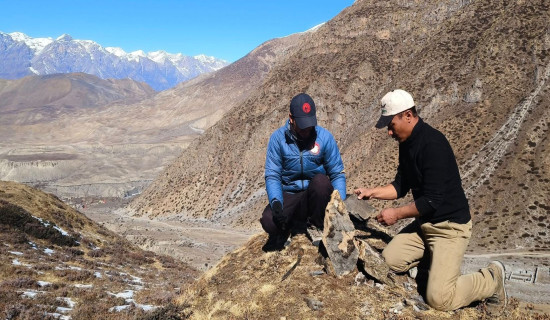- Monday, 1 December 2025
Ugratara fair begins in Dadeldhura
By Puskar Bhandari
Dadeldhura, Nov. 5: Ugratara Bhagawati Temple, which is believed to have a spiritual connection with Mount Kailash and the famous temple of Bholenath, Badrinath, is hosting a grand fair, Dehijaat, on Wednesday.
Ugratara Temple, one of the most revered shrines in the Sudurpachim, holds its annual worship and fair every year on the full moon day of the bright fortnight of the month of Kartik.
The temple is located in Dui, about five kilometres from the district headquarters of Dadeldhura. Situated in Amargadhi Municipality-8, the temple lies atop a large hill above Ratagun on the Mahakali Highway that connects Dadeldhura and Baitadi.
The main priests of Ugratara Bhagawati are of the Saanki Chhetri lineage.
The goddess does not have her own dhami (spiritual medium); instead, the main dhami of the deity Bhumi Raj Devata is regarded as the dhami of Ugratara Devi as well.
According to religious beliefs, the word Ugra means fierce or powerful; hence, Ugratara is considered a fierce and radiant form of the goddess. The fair becomes vibrant on the day of Kartik Shukla Purnima.
After the demise of the main priest from the Saanki lineage in 1976, the main priest has not been appointed, informed Ward Chairman Nar Bahadur Saanki of Ward No.8.
To the east of Ugratara, at the confluence Kisanar of the Renuka and Shalya rivers, lies the temple of Shaileshwor Mahadev.
Traditionally, a priest would receive the status of main priest only after traveling barefoot from Ugratara to the Shaileshwor Mahadev Temple. However, this religious tradition has not been followed for the past 49 years.
As a result, only minimal worship (Patali Puja) has been performed at both Ugratara Bhagawati and Shaileshwor Mahadev temples since then.
The rituals that require fasting and detailed worship as per the ancient tradition have not been carried out, he added.
According to Pushparaj Bhatt, the president of the Ugratara Veda Vidya Ashram and a devotee of Ugratara Bhagawati, the history of Ugratara is connected with Mansarovar.
He said that those who cannot travel to Mansarovar may visit Ugratara Mata instead, and their wishes will be fulfilled.
Similarly, those unable to visit the sacred shrine of Badrinath are believed to attain equal merit by worshipping at Ugratara Temple.
Before the Jaat rulers governed the region, they are believed to have directly commanded and mobilized the sacred stones (Shilas) of the deities.
“We worship these stones now,” he said, “but in those times, the Jaats could activate them, and the stones would perform divine acts.”
The main attraction of the Dehijaat fair is the ritual dance of the Gaaj (a sacred, umbrella-like structure). Decorated with ornaments of gold and silver and covered completely with fabric, the Gaaj is brought out of the temple and it dances to the rhythm of traditional music.
According to legend, this Gaaj was gifted to the Goddess Bhagawati by Bhumi Raj Devata. On the day of the fair, the Gaaj is taken to the main field of Bishal, where devotees pay homage to Goddess Durga Bhagawati, Bhumi Raj, Ganyap, and Bhageshwar. deities.














